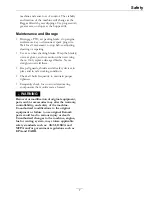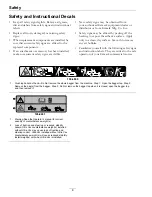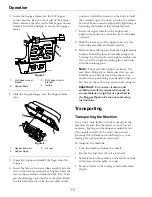
Safety
– After striking a foreign object or abnormal
vibration occurs (inspect the mower for
damage and make repairs before restarting
and operating the mower).
– Before clearing blockages.
– Whenever you leave the mower.
WARNING
Hands, feet, hair, clothing, or accessories can
become entangled in rotating parts. Contact
with the rotating parts can cause traumatic
amputation or severe lacerations.
•
Do Not operate the machine without
guards, shields, and safety devices in place
and working properly.
•
Keep hands, feet, hair, jewelry, or clothing
away from rotating parts.
•
Stop the blades, slow down, and use caution
when crossing surfaces other than grass and when
transporting the mower to and from the area to
be mowed.
•
Be aware of the mower discharge path and direct
discharge away from others.
Slope Operation
Use
Extreme
caution when mowing and/or turning
on slopes as loss of traction and/or tip-over could
occur. The operator is responsible for safe operation
on slopes.
DANGER
Operating on wet grass or steep slopes can cause
sliding and loss of control. Wheels dropping over
edges, ditches, steep banks, or water can cause
rollovers, which may result in serious injury,
death or drowning.
•
Do Not mow slopes when grass is wet.
•
Do Not mow near drop-offs or near water.
•
Do Not mow slopes greater than 15 degrees.
•
Reduce speed and use extreme caution on
slopes.
•
Avoid sudden turns or rapid speed changes.
•
Keep the roll bar in the raised and locked
position and use seat belt.
•
See inside the back cover to determine the
approximate slope angle of the area to be mowed.
•
Use a walk behind mower and/or a hand trimmer
near drop-offs, ditches, steep banks or water.
(Figure 3).
Figure 3
1.
Safe Zone-Use the mower here on slopes less than 15
degrees
2.
Danger Zone-Use a walk behind mower and/or hand
trimmer on slopes greater than 15 degrees, near
drop-offs and water.
3.
Water
•
Remove or mark obstacles such as rocks, tree
limbs, etc. from the mowing area. Tall grass can
hide obstacles.
•
Watch for ditches, holes, rocks, dips and rises that
change the operating angle, as rough terrain could
overturn the machine.
•
Avoid sudden starts when mowing uphill because
the mower may tip backwards.
•
Be aware that operating on wet grass, across steep
slopes or downhill may cause the mower to lose
traction. Loss of traction to the drive wheels may
result in sliding and a loss of braking and steering.
•
Always avoid sudden starting or stopping on a
slope. If tires lose traction, disengage the blades
and proceed slowly off the slope.
•
Follow the manufacturer’s recommendations for
wheel weights or counter weights to improve
stability. Always install and remove the Bagger,
including counter weights, as instructed. Failure
to do so will cause a reduction in stability or
traction. Do Not operate the mower with only a
portion of the Bagger installed.
•
Use extreme care with grass catchers or
attachments. These can change the stability of the
6






































